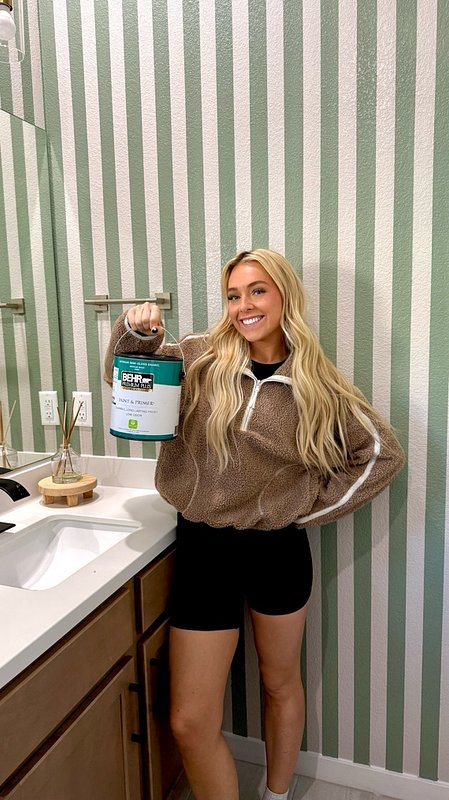
TikTok's 'Renter Revolution': How DIY is Democratizing Home Design
Serena Neel's viral bathroom makeovers are part of a growing trend empowering renters & women to transform their spaces – and disrupting the luxury home market.
TikTok's 'Renter Revolution': How DIY is Democratizing Home Design
Las Vegas, NV – November 8, 2025 – Forget gut renovations and million-dollar estates. A new wave of home design is sweeping across TikTok, fueled by creators like Serena Neel and a growing cohort of renters and first-time homeowners eager to personalize their spaces – without breaking the bank. Neel’s viral bathroom makeovers, culminating in her newly launched 'Holiday Bathroom' series, are emblematic of this ‘renter revolution,’ a phenomenon that’s not only democratizing design but also reshaping the luxury home market.
Neel, who boasts over 4.4 million TikTok followers, initially captured public attention with a bold striped bathroom transformation. The project, garnering over 50 million views, spawned a wave of copycat designs and cemented her status as a leading voice in accessible home improvement. Her recent 'Holiday Bathroom' series – beginning with a Halloween-themed reveal that amassed over 7 million views in days – demonstrates a savvy understanding of seasonal trends and a commitment to making design fun and approachable.
“It's about taking ownership of your space, regardless of whether you own it or rent it,” says a design industry analyst who requested anonymity. “For years, home improvement content focused on major renovations. Neel and others are showing people that you can create a beautiful, inspiring environment with paint, removable wallpaper, and a little bit of creativity.”
Beyond the Beige: A Shift in Aesthetic Control
The success of Neel’s content isn't isolated. Research indicates a significant uptick in women-led DIY content, coinciding with increased female participation in home improvement projects. Data from IBISWorld and Statista confirm this trend, showing a rising number of women initiating design decisions and taking on DIY projects. This isn't just about aesthetics; it's about regaining control over the home environment, particularly for those historically excluded from the design process.
“Traditionally, the home improvement industry was very male-dominated,” explains a marketing consultant specializing in the home decor space. “The messaging often focused on ‘fixing’ things, implying a problem that needed solving. Female creators are shifting that narrative, focusing on self-expression, creativity, and making a space feel good.”
Neel’s projects specifically resonate with renters, a demographic often overlooked by traditional luxury home brands. “Renters are a huge market, but they’re often treated as a secondary consideration,” says a real estate investor. “They’re hesitant to invest in major renovations because they don’t own the property. Creators like Neel are filling that gap, offering solutions that are affordable, temporary, and stylish.”
The Luxury Market’s Response – and Potential Disruption
The rise of DIY and renter-focused design presents both opportunities and challenges for the luxury home market. While some high-end brands may dismiss this trend as a passing fad, others are adapting to the changing landscape.
“We're seeing a shift in consumer priorities,” says an anonymous spokesperson for a major home decor retailer. “People are less interested in simply accumulating possessions and more interested in creating experiences and expressing their personality. This is driving demand for customizable, affordable, and sustainable design solutions.”
Several luxury brands are now collaborating with DIY influencers, offering curated collections of affordable products and providing online tutorials. Some are also experimenting with rental programs, allowing customers to ‘try out’ high-end furniture and decor before committing to a purchase.
However, the long-term implications of this trend remain to be seen. Some experts believe that the DIY movement could eventually disrupt the traditional luxury home market, as consumers become more comfortable with creating their own designs and less reliant on expensive professionals.
“The power dynamic is shifting,” says a design psychologist. “For years, designers dictated what was ‘in’ and what was ‘out.’ Now, consumers are taking control, curating their own spaces and expressing their individuality. This is a fundamental shift in the relationship between consumers and design.”
The Future of Home Design: Accessibility and Authenticity
Serena Neel’s success, and the broader ‘renter revolution,’ highlight a growing desire for accessible, authentic, and personalized home design. While luxury brands may continue to cater to a high-end clientele, the rise of DIY and renter-focused content is creating a more democratic and inclusive design landscape.
The key takeaway is clear: home design is no longer just about aesthetics; it's about self-expression, creativity, and creating a space that feels truly your own – regardless of your budget or housing situation. As one anonymous source put it, “The days of cookie-cutter interiors are over. People want their homes to reflect their personality and tell their story – and they’re willing to get their hands dirty to make that happen.”
Neel's 'Holiday Bathroom' series is a perfect example of this shift, proving that a little bit of paint, a few creative ideas, and a whole lot of personality can transform any space into a stylish and inviting sanctuary – even if it's just for a season.
